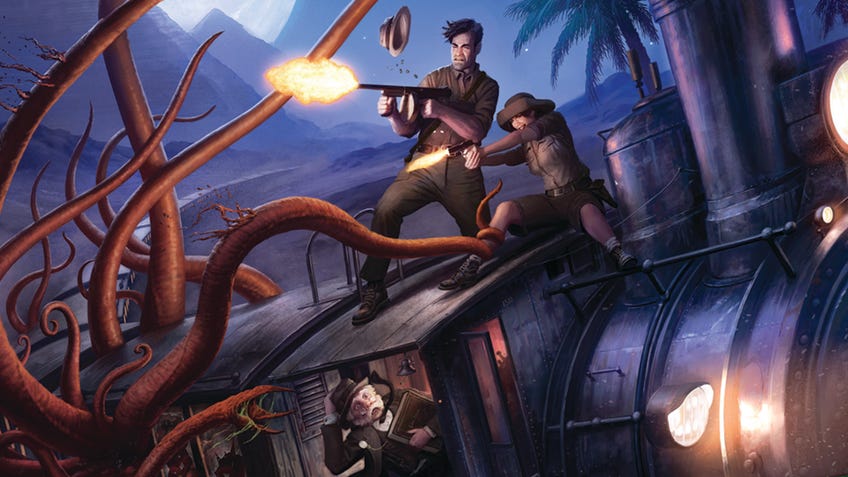Eldritch Horror creator reminisces on Omens, money and easter eggs for the board game's 10-year anniversary
Corey Konieczka’s “globetrotting Arkham Horror game” remains a high mark of collaborative tabletop design a decade later.
When Eldritch Horror released in 2013, it was meant to build on the already heady success of Fantasy Flight Games’ Arkham Horror 2nd Edition. The collaborative board game leverages Lovecraft’s mythos, incremental character building and a creeping sense of dread to create an experience that has delighted and frightened players for a solid decade.
Co-creator Corey Konieczka marked the occasion with a retrospective on FFG’s blog, reflecting on what he could remember of the years spent designing the original board game and its many expansions. Konieczka would go on to work on other massively popular titles - Battlestar Galactica: The Board Game, Star Wars: Rebellion, Twilight Imperium: Fourth Edition - but Eldritch Horror arguably launched his career, along with the designers now responsible for its legacy, such as Nikki Valens, Tim Uren and Dane Beltrami.
Konieczka said he practically leaped at the chance to design a “globetrotting Arkham Horror game” when FFG’s Christian Petersen levied the idea in 2012. Already a fan of the cosmic horror genre and the studio’s previous work, he wanted to lift the best bits of Arkham Horror 2E into this new design. “I borrowed so much that one could argue that I only designed half the game, but I suppose we all stand on the shoulders of giants,” he said.
For every encounter card and skill test successfully translated into Eldritch Horror’s design, something else needed to be entirely reworked. Konieczka believed death and insanity should be a real and ever-present threat to the player-controlled investigators, whether at the hands, guns and weapons of their enemies or the gradually encroaching influence of the Mythos. The Omen mechanic arose from a desire to reduce the number of ongoing rules in Arkham Horror 2E, ultimately solved by the randomly triggered effects attached to the Omen Track.
Spellcasting benefited from Eldritch Horror’s emphasis on telling a story through card descriptions and character development. Having random stories on the opposite side of spell cards proved so fun that Konieczka copied the framework for condition cards, too. When Valens joined the team in 2013, she helped transform the token-based money system ported directly from Arkham Horror into the skill test-governed use of Influence to purchase critical equipment, no matter where the investigators find themselves.
Konieczka conjured big dreams for Eldritch Horror from the jump, working with Uren to hide easter eggs for what would eventually become the Nyarlathotep expansion inside the board game’s rules. “We were pretty focused on finishing the core game at this time, so we only had a vague idea of what the expansion might look like. Regardless, we put the code in there thinking it would be a fun easter egg,” he said.

“When we actually started working on the expansion, it became pretty clear that Nyarlathotep needed way more than a small-box expansion could provide. The scope of the expansion was so big that it was kicked down the road for five whole years, and it eventually became the eighth and final expansion for the game,” Konieczka continued.
The past decade has apparently smeared away Konieczka’s memories of Eldritch Horror’s release in November 2013, but he swears that it remains one of the only titles he has enjoyed with friends and family, post-release. Fantasy Flight Games hasn’t touched one of its most successful and lasting series since Masks of Nyarlathotep was released in late 2017, but the enduring popularity and acclaim are a testament to the care and attention of its design team.


